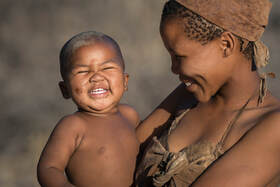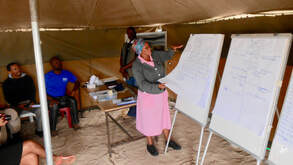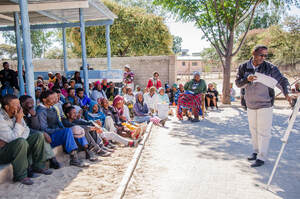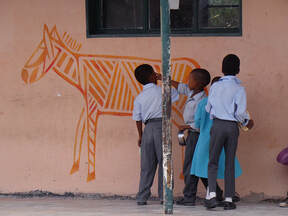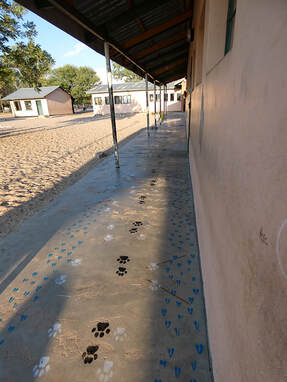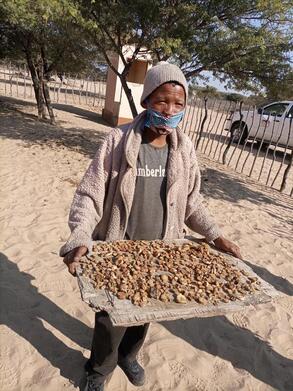COMMUNITIES FOR CONSERVATION
|
CCB's newest programme has been running since our initial participatory planning workshops in 2017. This long-term community-based conservation programme aims at working directly with communities in a variety of ways to promote the coexistence of people and wildlife and to safeguard the pristine wildlands of the Kalahari.
To safeguard Botswana's cheetahs, we first need to preserve the Kalahari's unique habitat. Central to this, is the work we are pioneering with the small villages in the heart of one large wildlife corridor that links the Central Kalahari Game Reserve and the Kgalagadi Transfrontier Park. Establishing partnerships with specialised and experienced organisations helps us to support communities so they can address their collective challenges and tap into their strengths, primarily by building the capacity of their own community-based organisation, facilitate the uptake of wildlife-based incomes and improve their ability to manage their natural resource base. By creating benefits from their natural resources, we hope to promote the conservation of the environment in this key wildlife area. CURRENT PROJECTS Building up the Capacity of the Community Trusts Community-based natural resource management (CBNRM) is a way in which communities can take ownership over their natural resources and can have not only a direct say in how their resources are managed, but also gain direct benefits from those resources. CBNRM is ideal in dual purpose Wildlife Management Areas, such as in the areas where our C4C programme is based. The success of any CBNRM project is reliant upon a strong foundation and effective Community Trusts – the group of community members selected to represent the community in the management of their resources. All three of the communities that we are working with in this area identified a need to develop skills within their Community Trusts. In 2020 we began workshops and skills training sessions to help them build their business skills and experience so that they can work towards effective management of their natural resources. Livelihood Diversification Extreme isolation means that income generation in these villages is hard to come by and most of the income derived is from livestock farming or from government welfare schemes. When poverty is persistent, the environment suffers, whether it be from bushmeat poaching (poaching wildlife for meat), overgrazing of livestock or a reduced tolerance of carnivores. By encouraging the diversification of livelihoods, we hope to not only give these communities the tools to build themselves up financially, but by promoting sustainable natural resource utilisation we can give them more direct benefits from nature and therefore more motivation to protect the environment around them. Women’s Skills Development CCB will be working directly with the women in these communities to develop wildlife-based income streams such as traditional crafts. By working with stakeholders from Ghanzi Craft and the Kalahari Wildlands Trust, we are working to build skills in craft development and the accompanying value chain, in the hope that the women from these communities can begin successful enterprises and become beacons of conservation within their communities. Stakeholder Engagement Landscape level conservation cannot be achieved in isolation and this Communities for Conservation programme requires coordination with numerous government and non-government entities. In order to streamline the process, in 2020 we partnered with Kalahari Research and Conservation, the UNDP and Karunya Consulting to develop a Human-Wildlife Conflict Management Strategy for the entire region. This strategy highlights the importance of this region for wildlife, the key challenges faced and the priorities of the villages in how they wish to develop moving forward. Using this strategy and as an active member of the CBNRM Technical Advisory Committee for the villages in these areas, we can support the development of these villages in order to help them to conserve their natural resources. PREVIOUS PROJECTS COVID-19 Support for our Target Communities When Botswana went into a strict national lockdown at the end of March 2020, our isolated target villages were forced into a difficult situation. With government work-for-welfare schemes suspended and government aid struggling to reach these extremely remote villages, CCB jumped in to assist the government in providing the support that these communities needed. After consultations with community liaisons and local council representatives, we provided our communities with hygiene packs, hand-washing stations in key areas in the villages and cheetah-themed hygiene posters in the local language. We also contracted local sewing groups to produce the 2,600 masks that were needed to supply every man, woman and child in the villages with reusable cloth face masks. Although somewhat removed from our usual activities, we were thankful that we were able to help our target communities in their time of need and we know that this intervention will go along way to show the communities that we are committed to supporting them. Thankfully they managed to weather the lockdown and they now have the resources available to them now to protect themselves moving forward. Community Participatory Planning Process CCB went through a thorough participatory planning process with three villages that lie in the middle of this crucial wildlife corridor – Bere, Kacgae and New Xade. The communities themselves laid out what they believed their challenges were and what areas of development they wished for in their villages. Although many of the areas where they need assistance are not directly related to conservation, we are aware that the villagers’ ability to conserve wildlife can be hampered if these issues are not addressed. As such, we began the process within our own organisation to identify what areas we can focus on with our activities and what areas we can involve other stakeholders to assist with. The entire process was well attended by the communities and we celebrated in each village with traditional dances and soccer matches. We look forward to securing ongoing funding for these villages, so that they can work towards protecting their natural resources and benefiting from this incredible resource. Celebrating Wildlife in Schools Part of this project is aimed at creating a sense of pride in the San's natural and cultural resources. A recent visit by professional artist Karrie Hovey saw the Bere Primary School transform with murals depicting the art of the school's students. Karrie also painted footprints of wildlife along the corridors of the school to remind the students of their traditional culture of tracking spoor (footprints). CCB's Education team is continue to work closely with the Primary Schools in both communities, with regular school visits and bush camps to encourage a passion for the environmental within the students. The deputy headteacher of Bere Primary School, Keene Ramotsana, attributed an improvement in the student's performance at school with the interventions CCB had done with the students. "It is because of you (CCB) and the work that you do here, that these students are doing so well in school." |

